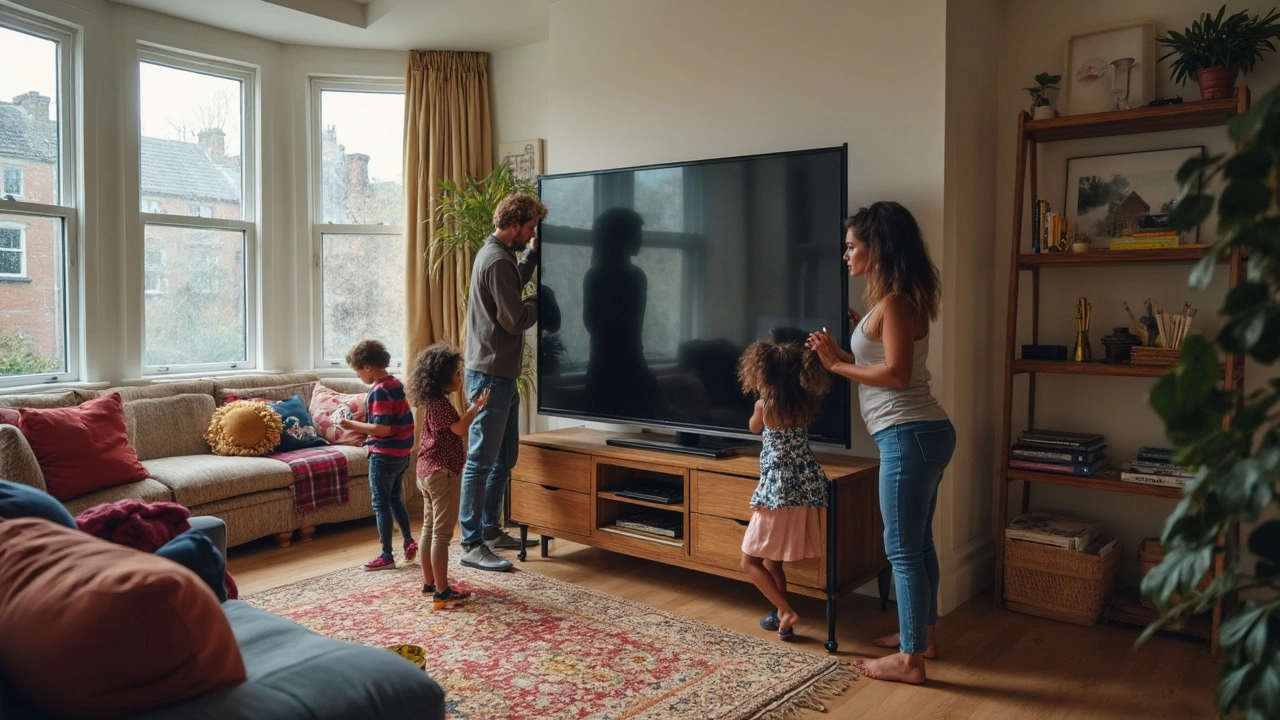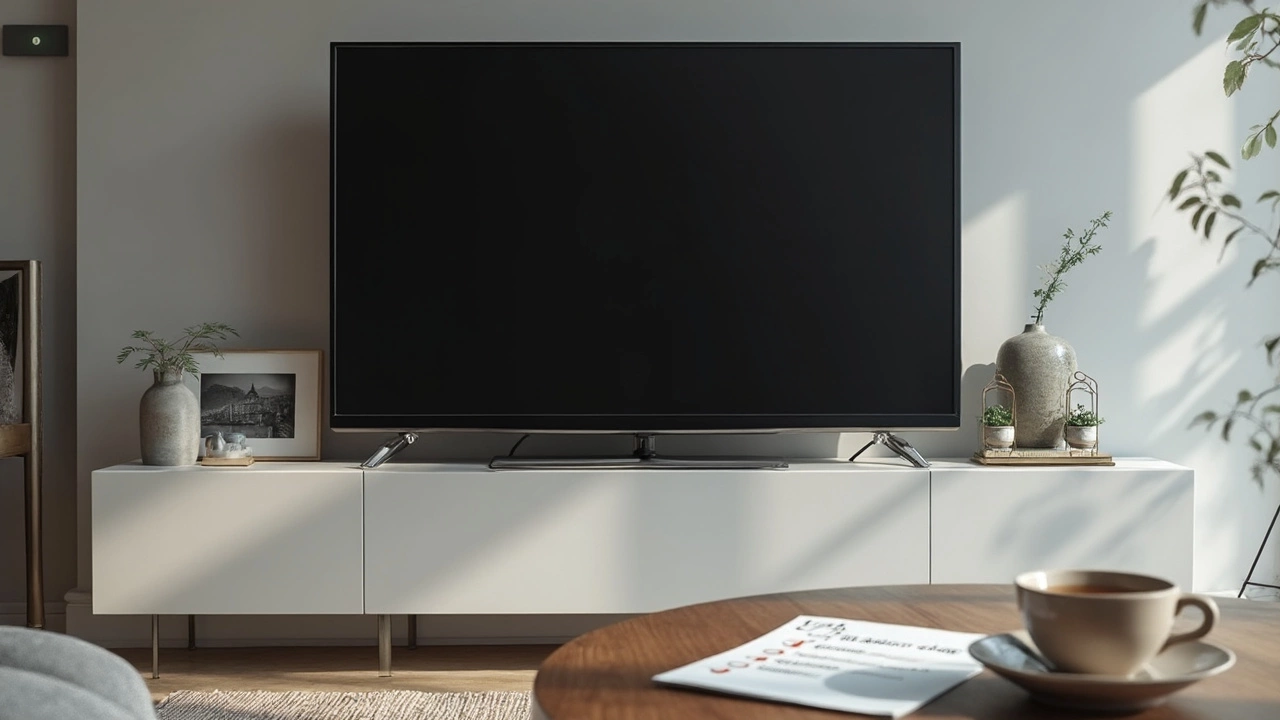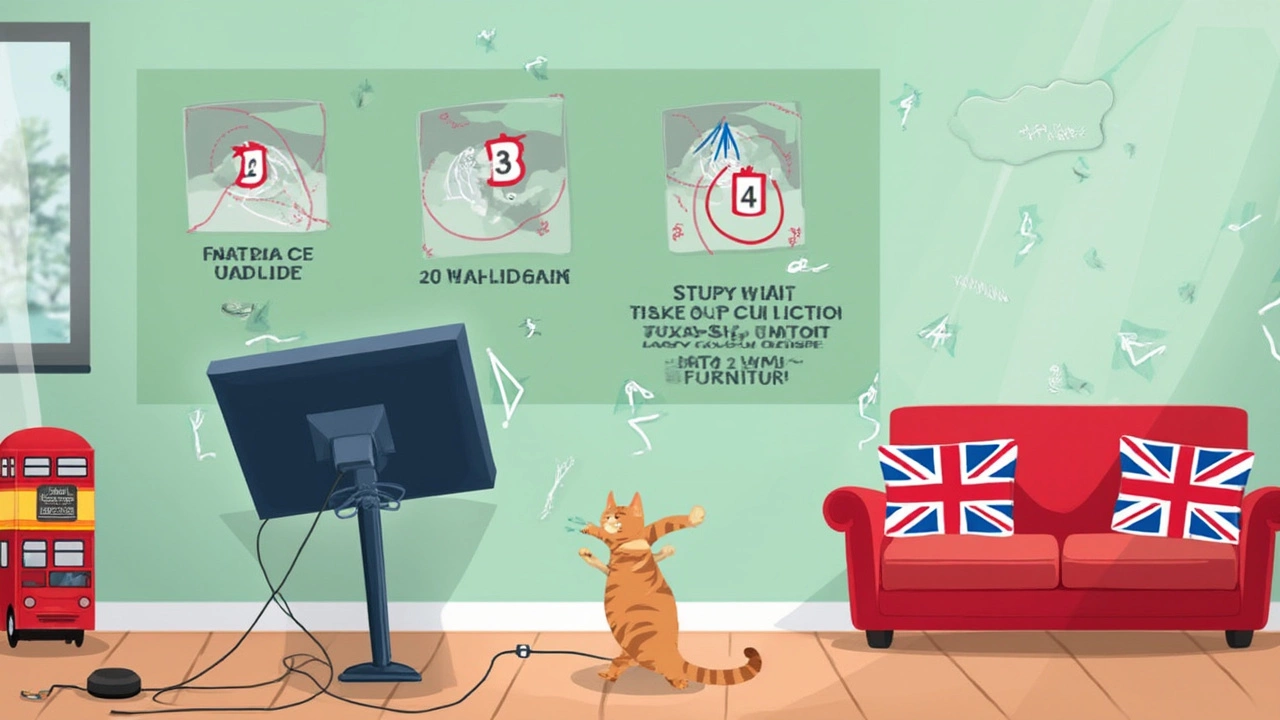 20
May,2025
20
May,2025
So you’ve just brought home a shiny new flat screen and now you’re staring at your old TV stand, wondering, “Is this actually okay?” This isn’t just about looks—it’s about safety, too. Most flat screens can work perfectly on a stand, but not all stands are up for the job. The wrong combo can lead to a wobbly mess or worse, a busted TV and a big headache.
Before you even lift that TV, there are a couple of details you absolutely need to check. How wide is your stand compared to the TV’s feet or base? Can the stand actually handle your screen’s weight? The last thing you want is a stand that buckles or tilts every time someone walks past.
- Can You Put a Flat Screen TV on a Stand?
- What Makes a Stand Safe for Your TV?
- How to Pick the Right TV Stand
- Tips for Setting Up Your TV on a Stand
- Common Problems and How to Avoid Them
Can You Put a Flat Screen TV on a Stand?
Yes, you can absolutely put a flat screen TV on a stand—as long as you match the size and weight of your TV to the stand. Most modern flat screens are designed with this in mind, and the majority of TVs either come with a stand or have mounting holes that fit most universal stands. The real trick is making sure the stand you’re using was made for your TV's size and style.
Just to get specific: Most flat screens (even big 65-inch ones) can safely chill on a stand if it’s rated for that weight. For example, a typical 55-inch LED TV weighs about 30 to 50 lbs. Most TV stands built after 2015 support at least 80 lbs. But don’t just guess—check your TV’s manual for exact specs.
Placement matters too. Never let your screen hang over the edges of a stand—you’re just asking for trouble with accidental bumps. Experts recommend having at least two inches of space between the TV’s base or feet and the sides of the stand.
"A stand that doesn't properly support the size and weight of your TV is one of the fastest ways to end up with a cracked screen or worse. Always follow the manufacturer's guidelines." — Consumer Reports, 2024
Have little kids or pets around? They might pull or bump into your TV. One in four TV injuries involve a screen that tipped because the stand was too small or unsteady, according to a 2023 safety report from the US Consumer Product Safety Commission.
| TV Size (inches) | Average TV Weight (lbs) | Minimum Recommended Stand Width (inches) |
|---|---|---|
| 32 | 9-15 | 28 |
| 50 | 25-35 | 44 |
| 65 | 45-60 | 58 |
| 75 | 75-100 | 66 |
Bottom line: if your flat screen TV fits the stand in both width and weight, you’re golden. Just don’t forget to double-check those numbers before setting up. Being a little extra sure goes a long way in keeping your TV (and everyone else) safe.
What Makes a Stand Safe for Your TV?
Let’s cut to the chase—plopping your TV on just any stand can be risky. Not every piece of furniture that holds stuff is designed to take the weight or balance of a modern TV. Here’s what actually makes a stand safe and solid for your setup.
The most basic thing is size. Your stand should be at least as wide as the feet or base of your TV. A stand that’s too small? That’s asking for trouble. Next up is weight. Even though flat screens are lighter than old-school TVs, they’re not exactly featherweight. Most manufacturers will tell you exactly how much weight their stands can support—so don’t just guess. Check those numbers before you even move your TV.
Then you’ve got stability. Some stands might look cool, but if they wobble even a little, you’re risking an accidental tip-over. Hardwood, thick glass, or reinforced metal stands are way more reliable than particle board or anything lightweight. Good news: most stands these days list their weight limits on a sticker or in the manual.
Don’t forget about surface grip. Some TV bases are super slippery. If the stand’s surface is slick—like polished glass—add a non-slip mat or stick-on bumpers under your TV base. Here are the main things every TV stand needs to be safe:
- At least as wide as the TV’s base or feet
- Weight limit higher than your TV’s actual weight (add a little extra for safety)
- Flat, even surface—wobbly or warped stands are not safe
- No overhanging edges—edges sticking out are just waiting to get bumped
- Sturdy materials: look for solid wood, metal, or thick tempered glass
Want some fast numbers? Here’s a quick reference for standard flat screen weights and typical stand limits:
| TV Size | Average TV Weight | Suggested Stand Weight Limit |
|---|---|---|
| 32" | 10-15 lbs | At least 25 lbs |
| 55" | 25-35 lbs | At least 50 lbs |
| 65" | 45-60 lbs | At least 80 lbs |
| 75" | 65-90 lbs | At least 120 lbs |
Keep in mind, the flat screen TV of today can still be heavy enough to mess up a cheap or flimsy stand. Play it safe and always double check the specs from your TV and stand before you commit.

How to Pick the Right TV Stand
Not every TV stand will do the job for your flat screen. You don’t want your new TV looking awesome one minute and then face-first on the floor the next. So, how do you make sure you’re picking the right one?
Here are a few things that matter most:
- Width: Your stand should be at least as wide as the base or legs of your TV. If your screen sticks out, it’s more likely to get knocked over.
- Weight limit: Every stand has a max weight it can handle. Always check the specs on both your TV and the stand before buying or setting things up.
- Height: Ideally, your eyes should hit the middle of the TV when you’re sitting down. And if you have kids or pets, lower stands are less likely to tip if bumped.
- Material and build: Heavier materials like solid wood or thick metal are harder to tip over and last longer than cheap particle board.
- Extra support: Some stands come with mounting brackets for extra safety. Consider them if you want that extra peace of mind.
According to Consumer Reports,
"For stability, the stand’s width should be equal to or greater than the TV itself, and weight support must not be overlooked. TVs can weigh between 25 to 100 pounds depending on size and make."So yeah, ignoring those numbers can get you in trouble fast.
Here’s a cheat sheet for popular TV sizes and what to look for in a stand:
| TV Size | Average TV Weight (lbs) | Recommended Stand Width (inches) | Minimum Weight Capacity (lbs) |
|---|---|---|---|
| 32" | 10-15 | 30+ | 25 |
| 50" | 20-30 | 45+ | 40 |
| 65" | 45-65 | 58+ | 70 |
| 75" | 75-100 | 68+ | 100 |
Look for stands with cable management if you hate the sight of tangled cords. And if you’re tight on space, there are stands with shelves or drawers for your consoles and remotes. Shopping online? Double check user reviews for surprise stability problems. Trust me, nothing’s worse than a wobbly setup you only discover after assembling the thing.
Tips for Setting Up Your TV on a Stand
Getting your flat screen TV safely set up on a stand comes down to a few simple but crucial steps. A quick double-check now can save you a world of trouble (and maybe a pricey repair bill) later.
First, measure both the width of your TV’s base or feet and the surface area of your stand. If your TV’s stand barely fits or hangs over the edge, that’s just asking for disaster. As a rule of thumb, leave at least an inch or two on each side of the TV base for stability.
- Clear off clutter. Even a couple of remotes or magazines can make a difference in how stable your TV feels.
- Double-check the weight capacity. Most modern stands come with a max weight listed in the manual or on a sticker underneath. Never guess this—look it up if you’re not sure.
- Use anti-tip straps for extra safety. These handy straps (sold online or at big box stores) keep the TV anchored to the wall, and a lot of parents swear by them for kid-proofing.
- Keep cables tidy and out of the way. Bungled-up cords not only look messy, but someone can pull them and bring the whole TV down.
"A sturdy TV stand that’s properly matched to your television size and weight is your best insurance against an accidental tip-over—especially if you’ve got kids or pets at home." — Consumer Reports, Feb 2024
Let’s break down some numbers so you can see how important the right fit is. Check out the average weights of different TV sizes and what most mid-range stands can support:
| TV Size | Average TV Weight (with stand) | Typical Stand Max Capacity |
|---|---|---|
| 32" | 10-15 lbs | 50-75 lbs |
| 55" | 30-45 lbs | 75-100 lbs |
| 65" | 50-70 lbs | 100-150 lbs |
And one last tip: always place the stand and TV on a flat surface. Even a little tilt in the floor can mess with stability. Give your setup a gentle push after you’re done. If it wobbles, don’t ignore it—readjust until you’re confident it’s rock solid.

Common Problems and How to Avoid Them
You’d be surprised how often people get tripped up by the basics when putting a flat screen TV on a stand. One of the biggest issues? The TV isn’t actually stable. A lot of folks use stands meant for older, chunkier TVs, forgetting that flat screens often have wider feet or a more awkward center of gravity. Result: your TV is just waiting for a bump or a curious pet to send it tumbling.
Another common headache is weight limits. Stands—especially older or super cheap ones—have a max weight they can handle. Ignore that, and you risk your stand slowly sagging or even snapping. Check the paperwork or sticker underneath if you’re not sure what your stand can carry.
Cable chaos is another classic. It’s easy for power cords or HDMI wires to get yanked or tangled, which can actually pull your TV off balance. Tripping over a cable is one of the top reasons TVs hit the floor. Use zip ties, clips, or even sticky cable organizers to keep things tidy and secure.
If you’ve got kids or pets racing around, a wobbly TV is a real safety hazard. More than 15,000 people end up in the ER every year in the US thanks to TV tip-overs. To make sure yours stays put, use anti-tip straps or mounting anchors. They’re cheap and super easy to install.
Here’s a quick checklist to keep you out of trouble:
- Match your TV base or feet width with the stand’s top surface.
- Confirm the stand’s weight rating beats your TV’s weight by at least 20%.
- Secure all cables and keep them out of walking paths.
- Use anti-tip kits if you have kids, pets, or just want extra peace of mind.
- Double-check that your stand is on a flat, even surface—no wobbly floors or rugs.
If you check these boxes, you’ll cut your odds of TV disasters way down and keep your setup safe as well as sharp-looking.




